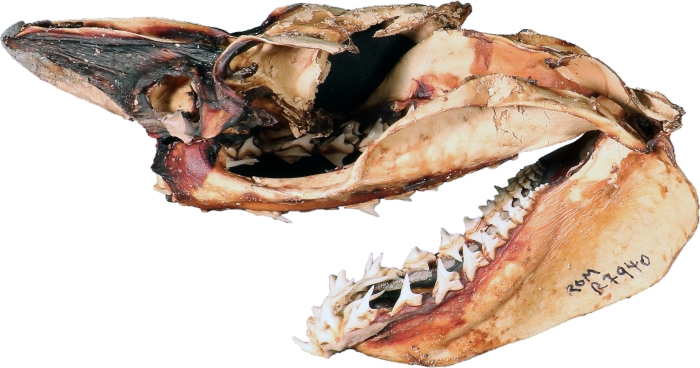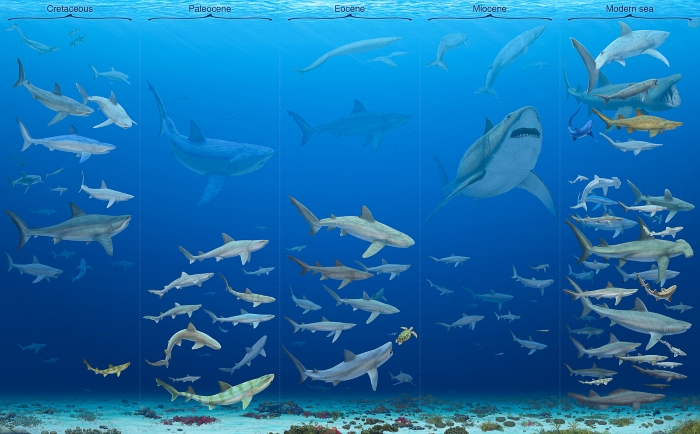A new study, where 3 000 shark teeth were analyzed, provides new insight into how modern shark communities were established. The results are published in the journal Current Biology.
The new research investigated the diversity of shark teeth from the final stages of the Mesozoic (approximately 80 million years ago) to today. In particular, it sought to understand why there are only 15 species of mackerel sharks living today (scientific name: Lamniformes), whereas there are more than 290 species of ground sharks (Carcharhiniformes).
“The modern-day imbalance in diversity between the mackerel ground sharks have, until now, lacked a deep-time ecological perspective. However, if we look to the past, we see the opposite pattern: lamniforms were more diverse than carcharhiniforms” says study leader Dr Mohamad Bazzi, previously a researcher at Uppsala University but now at the University of Zurich.
The evolution of sharks is a story told by their teeth. This is because most of what remains behind for paleontologists to work on are shed teeth. As a result, researchers must seek innovative approaches to help us fill out the many gaps in knowledge that relates to their past.

Image: The Shortfin mako, Isurus oxyrinchus (ROM R7940). Scale bar = 100 mm (Image by Mohamad Bazzi)
"Tooth morphology is a more direct proxy for the living habits of sharks and our study is the first attempt to explore how diet impacted lamniform and carcharhiniform sharks over the past 83 million years. By measuring the association between tooth shapes and diets from living sharks, we built a foundation for interpreting changes in diet in the fossil record," says Dr Bazzi.
The research team compiled an extensive database of over 3000 shark teeth and then evaluated their shape. To attain a measure of shape diversity (or disparity as it’s technically called) the study relied on a method known as geometric morphometrics, which is a type of mathematical shape analysis.
Likewise, to understand the role diet played in shaping the diversity of sharks, the team assembled previously published records of sharks diets attained from stomach contents.
Many Cretaceous Lamniformes had specialized diets for eating marine reptiles and, following their loss at the end of the age of dinosaurs, these Lamniformes went extinct. On the other hand, Lamniformes with more generalized diets and Carcharhiniformes survived the extinction event. Carcharhiniforms particularly benefited from the diversification of bony fish following the extinction event, and the spread of coral reefs about 56 million years ago.
As it turns out, the same extinction that killed off the non-bird dinosaurs, may have set the stage for the modern shark community.
A similar event may have occurred only 5 million years ago to the largest shark to have ever existed, the lamniform megalodon (scientific name: Otodus megalodon).
Megalodon fossils are mostly from the Miocene (which spanned from approximately 23 to 5 million years ago). During this period, lamniform sharks had record-low tooth disparity. Megalodon likely specialized on eating the large whales of that time and so this low disparity again suggests that specialized diets among top predatory sharks may be placing them at a greater risk of extinction.
“Here, we have a good example of the important biological insights offered by studying fossils,” says Dr Nicolás Campione, co-author and member of the University of New England’s Palaeoscience Research Centre.
“Our research demonstrates that living Lamniformes are the result of repeated extinction events, perhaps resulting from a tendency to specialize. Dietary specialization, on top of environmental changes, were likely major factors behind the previously mentioned imbalance between Lamniformes and Carcharhiniformes,” says Dr Campione.
“We now have evidence that the availability of prey and the ability of sharks to adapt to changing environments played an important role in their past evolution. These factors underpinned the modern diversity of sharks and, critically, will likely decide their survival into the future,” says Dr Bazzi.


